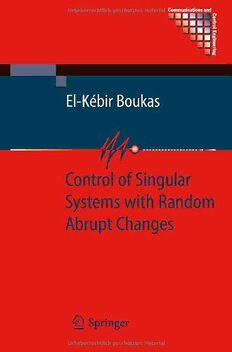
Control of Singular Systems with Random Abrupt Changes PDF
Preview Control of Singular Systems with Random Abrupt Changes
Communications and Control Engineering SeriesEditors E.D.Sontag·M.Thoma·A.Isidori·J.H.vanSchuppen Publishedtitlesinclude: StabilityandStabilizationofInfinite RobustControl(Secondedition) DimensionalSystemswithApplications JürgenAckermann Zheng-HuaLuo,Bao-ZhuGuo FlowControlbyFeedback andOmerMorgul OleMortenAamoandMiroslavKrsti´c NonsmoothMechanics(Secondedition) LearningandGeneralization BernardBrogliato (Secondedition) NonlinearControlSystemsII MathukumalliVidyasagar AlbertoIsidori ConstrainedControlandEstimation L2-GainandPassivityTechniques GrahamC.Goodwin,MaríaM.Seron inNonlinearControl andJoséA.DeDoná ArjanvanderSchaft RandomizedAlgorithmsforAnalysis ControlofLinearSystemswithRegulation andControlofUncertainSystems andInputConstraints RobertoTempo,GiuseppeCalafiore AliSaberi,AntonA.Stoorvogeland andFabrizioDabbene PeddapullaiahSannuti SwitchedLinearSystems RobustandH∞Control ZhendongSunandShuzhiS.Ge BenM.Chen SubspaceMethodsforSystemIdentification ComputerControlledSystems TohruKatayama EfimN.RosenwasserandBernhardP. DigitalControlSystems Lampe IoanD.LandauandGianlucaZito ControlofComplexandUncertainSystems MultivariableComputer-controlledSystems StanislavV.EmelyanovandSergeyK. EfimN.RosenwasserandBernhardP.Lampe Korovin DissipativeSystemsAnalysisandControl RobustControlDesignUsingH∞Methods (Secondedition) IanR.Petersen,ValeryA.Ugrinovski BernardBrogliato,RogelioLozano, andAndreyV.Savkin BernhardMaschkeandOlavEgeland ModelReductionforControlSystemDesign AlgebraicMethodsforNonlinearControlSystems GoroObinataandBrianD.O.Anderson (Secondedition) ControlTheoryforLinearSystems GiuseppeConte,ClaudeH.Moogand HarryL.Trentelman,AntonStoorvogel AnnaMariaPerdon andMaloHautus PolynomialandRationalMatrices FunctionalAdaptiveControl TadeuszKaczorek SimonG.FabriandVisakanKadirkamanathan Simulation-basedAlgorithmsforMarkov Positive1Dand2DSystems DecisionProcesses TadeuszKaczorek HyeongSooChang,MichaelC.Fu,JiaqiaoHu andStevenI.Marcus IdentificationandControlUsingVolterraModels FrancisJ.DoyleIII,RonaldK.Pearson IterativeLearningControl andBobatundeA.Ogunnaike Hyo-SungAhn,KevinL.MooreandYangQuanChen Non-linearControlforUnderactuated DistributedConsensusinMulti-vehicle MechanicalSystems CooperativeControl IsabelleFantoniandRogelioLozano WeiRenandRandalW.Beard El-K´ebir Boukas Control of Singular Systems with Random Abrupt Changes 123 Prof.E.K.Boukas MechanicalEngineeringDepartment E´colePolytechniquedeMontr´eal SuccirsaleCentre-VilleH3C 3A7Montreal,Quebec Canada email:[email protected] ISBN:978-3-540-74344-6 e-ISBN:978-3-540-74345-3 DOI10.1007/978-3-540-74345-3 CommunicationsandControlEngineeringSeriesISSN:0178-5354 LibraryofCongressControlNumber:2007934281 ©2008Springer-VerlagBerlinHeidelberg Thisworkissubjecttocopyright.Allrightsarereserved,whetherthewholeorpartofthematerial isconcerned,specificallytherightsoftranslation,reprinting,reuseofillustrations,recitation,broad- casting,reproductiononmicrofilmorinanyotherway,andstorageindatabanks.Duplicationof thispublicationorpartsthereofispermittedonlyundertheprovisionsoftheGermanCopyrightLaw ofSeptember9,1965,initscurrentversion,andpermissionforusemustalwaysbeobtainedfrom Springer.ViolationsareliabletoprosecutionundertheGermanCopyrightLaw. Theuseofgeneraldescriptivenames,registerednames,trademarks,etc.inthispublicationdoesnot imply, even in theabsence of a specific statement, thatsuchnames are exempt from the relevant protectivelawsandregulationsandthereforefreeforgeneraluse. Coverdesign:LE-TEXJelonek,Schmidt&V¨ocklerGbR,Leipzig TypesettingandProduction:LE-TEXJelonek,Schmidt&V¨ocklerGbR,Leipzig Printedonacid-freepaper 987654321 springer.com Dedicated tomywifeSaida andmy kidsImane,Ibtissamaand Anas Preface Singular systems also referred to as descriptor systems, implicit systems, general- ized state-space systems, differential-algebraic systems or semi-state systems (see [43,76])representsaninterestingclassofdynamicalsystemssinceitcombinesdif- ferentialequationsandalgebraicequationsandgeneralizesthelineartimeinvariant modelwhichis extensivelyused in linearcontroltheory.Thisclass of systemshas been used to model varieties of systems like economics, chemical processes, me- chanics,electricalsystems,etc.Singularsystemshaveattractedalotofresearchers from the mathematicaland controlcommunitiesand a great numberof fundamen- tal notionsand resultsin controland systemstheorybased onlinear time-invariant systemswithstatespacerepresentationhavebeensuccessfullyextendedtotheclass of singular systems. For more details on what it has been done on this subject we referthereaderto[3,4,51,75,122,123,127,50,109,112,122,124,126],andthe referencestherein.Morespecifically,wetackledthestabilityandthestabilizability ofthe classoflinearcontinuous-timesingularsystemsandmanyresultshavebeen reportedintheliteratureintheLMIsetting.Amongtheseresultswequotethoseof [14].Therobuststabilityandtherobuststabilizationhavealsobeenstudied.Many typesofuncertaintieshavebeenconsideredamongthemwequotethenormbounded form,thelinearfractionaltransformation(LFT,whichgeneralizesthenormbounded type)andpolytopicform. TheH∞controlandthefilteringproblemshavealsobeentreatedandinteresting resultswerereportedintheliterature.FortheH∞control,undertheassumptionsthat theexternaldisturbanceshavefinitepowerorfiniteenergy,acontrollawisdesigned to guarantee that the closed-loop system is regular, impulse-free and stable and at the same time assures the disturbance rejection with a given level γ > 0. For the filteringproblem,theobjectiveistodesignadynamicalestimatorthatestimatesthe state vectorthat can be used in the controlto make the closed-loopof the singular systemregular,impulse-freeandstable. Someofthepracticalsystemsarestochasticormorespecificallywecanmodel thembyaclassofstochasticsystemsdrivenbycontinuous-timeMarkovchainsthat wewillrefertoastheclassofstochasticsystemswithabruptchanges.Thisclassof systemsismoreappropriatetomodelmanypracticalsystems,whererandomfailures VIII andrepairsandsuddenenvironmentchangesmayoccur.Formoredetailonwhatit has been done on the subject, we refer the reader to [27], [96] and the references therein.Thisclassofsystemshasalsoattractedalotofresearchersfrombothmath- ematicalandcontrolcommunity.Manyresultsonstochasticstabilityandstochastic stabilization have been reported in the literature. For more details on these results wereferthereaderto[29,26,49,60,94]andthereferencestherein,wheredifferent approacheshavebeenused.TheH∞ controlproblemwasinvestigatedin[45,105], wheresufficientconditionsforthe solvabilityofthisproblemwasproposed.When timedelaysappearinaMarkovianjumpsystem,theresultsonstabilityanalysisand H∞ controlwerealsoreportedin[31],[24]and[25]fordifferenttypesoftimede- lays. For moredetail on Markovianjumpingsystems with time delay,we refer the readerto[14,27]andthereferencestherein. Ourgoalinthisvolumeistocombinetheclassofsingularsystemswiththeone of systems with abrupt changes which will give the class of systems that we will refer to as the class of stochastic singular systems with abrupt changes. Our main objectiveinthisvolumeistotreatthestabilityandthestabilizationproblemsusing differenttechniques.Wewillalsohandlethefilteringproblem. Therestofthisbookisorganizedasfollows.InChap.1,thedifferentproblems arestatedandthenecessaryassumptionsaregiven.Chapter2dealswiththestabil- ity problemof the class of singularsystems with randomabruptchangesand LMI conditionsaredevelopedtocheckifagivensystemofthisclassofsystemsispiece- wise regular,impulse-freeandstochasticallystable.Therobuststabilityproblemis alsoconsidered.Chapter3 treatsthe stabilizationproblemanditsrobustness.State space controllersare consideredand LMI design approachesare developed.Chap- ter 4 deals with the H∞ control for the class of singular piecewise deterministic systems.InChap.5,thestaticoutputstabilizationistackledandLMIresultsarede- veloped for the class of singular systems with random abrupt changes. The robust caseisalsoconsidered.Chapter6dealswithobserver-basedoutputstabilizationfor the class of Markovianjump singular systems. In Chapt. 7 the filtering problemis consideredand design proceduresare proposedin the LMI formalism to solve the theH∞filteringproblem.InChap.8,theguaranteedcostcontrolproblemistackled andLMIresultsaredevelopedtosynthesizethestatefeedbackcontrollerthatmakes the closed-looppiecewise regular,impulse-freeandstochastically stable andat the sametimeguaranteedanupperboundforthecostforalladmissibleuncertainties.In Chap.9,themixedH2/H∞ controlistackledanddesignprocedureisdevelopedto synthesizeastatefeedbackcontroller.Finally,Chap.10providessometoolsthatcan beusedtosolvealltheLMIconditions.Itgivesanideatothereaderonhowtowrite hisprogramunderMathlabtosolvetheconsideredproblemofthisclassofsystems. Contents PartI Modelingandproblemstatements 1 Introduction .................................................. 3 1.1 ExamplesofSingularSystems................................ 4 1.2 ProblemStatements ........................................ 10 1.3 SolutionfortheDynamics ................................... 14 1.4 StochasticH2 andH∞ Norms................................ 16 1.5 Lemmas .................................................. 17 1.6 Notes..................................................... 18 PartII Stochasticstability 2 Stability....................................................... 23 2.1 ProblemStatement ......................................... 23 2.2 StabilityofSingularSystems................................. 25 2.3 RobustStability............................................ 32 2.4 NumericalExamples........................................ 39 2.5 Notes..................................................... 43 PartIII Stabilization 3 StateFeedbackStabilization..................................... 49 3.1 ProblemStatement ......................................... 49 3.2 DesignofStateFeedbackStabilization......................... 51 3.3 ConstantGainStateFeedbackStabilization..................... 67 3.4 NumericalExamples........................................ 77 3.5 Notes..................................................... 80 X Contents 4 H∞ Stabilization............................................... 81 4.1 ProblemStatement ......................................... 81 4.2 H∞ StateFeedbackStabilization ............................. 82 4.3 H∞ ConstantGainStabilization .............................. 113 4.4 NumericalExamples........................................ 127 4.5 Notes..................................................... 130 5 OutputFeedbackStabilization................................... 131 5.1 ProblemStatement ......................................... 131 5.2 StaticOutputFeedback...................................... 133 5.3 H∞ StaticOutputFeedbackControl........................... 143 5.4 NumericalExamples........................................ 151 5.5 Notes..................................................... 155 6 Observer-BasedFeedbackStabilization........................... 157 6.1 ProblemStatement ......................................... 158 6.2 Observer-BasedStabilizationofSingularSystems ............... 159 6.3 RobustObserver-BasedStabilizationofSingularSystems......... 168 6.4 NumericalExample......................................... 176 6.5 Notes..................................................... 179 PartIV Filtering 7 Filtering ...................................................... 185 7.1 ProblemStatement ......................................... 185 7.2 H∞ FilteringforNominalSystems............................ 187 7.3 RobustFiltering............................................ 196 7.4 NumericalExamples........................................ 209 7.5 Notes..................................................... 211 PartV SingularOptimalControl 8 GuaranteedCostControl ....................................... 217 8.1 ProblemStatement ......................................... 217 8.2 GuaranteedCostBound ..................................... 219 8.3 GuaranteedCostControlDesign.............................. 222 8.4 NumericalExample......................................... 228 8.5 Notes..................................................... 230 9 MixedH2/H∞ ControlProblem................................. 231 9.1 ProblemStatement ......................................... 232 9.2 MixedH2/H∞Control:NominalCase ........................ 235 9.3 MixedH2/H∞Control:UncertainCase ....................... 242 9.4 NumericalExample......................................... 248
